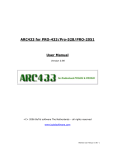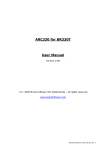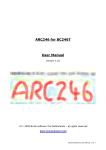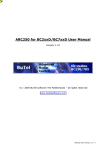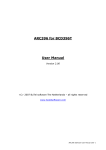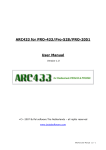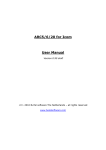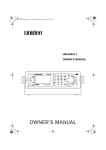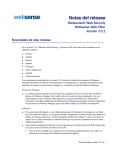Download Uniden BCT8 User manual
Transcript
ARC8 for Uniden BCT8 Trunktracker User Manual Version 0.90 <C> 2004 BuTel software The Netherlands – all rights reserved www.butelsoftware.com ARC8 User Manual 0.90 - 1 Contents: 1 Introduction and quick start reference 1.1 Software Installation 1.2 Enter registration information 1.3 Connecting the scanner to your PC 1.4 RS232 port setup 1.5 USB information 2 Using the memory channel editor 2.1 Reading data from the scanner 2.2 General hints and tips for using the editor 2.3 Programming conventional frequencies 2.4 Programming trunk frequencies 2.5 Sort data 2.6 Easy Fill 2.7 Using the clipboard 2.8 Copy/Move/Swap banks/channels 2.8.1 Copy/Move/Swap memory channels 2.8.2 Copy/Move/Swap memory banks 2.9 Fill Down / Fill Series 2.10 Other editor options 2.11 Importing frequencies from a website using WebCatcher 2.12 Priority Channels 2.13 Active Banks 2.14 Sending data to the scanner 2.15 Import/Export data 3 Programming trunk systems 3.1 Motorola Type 2 - 800 MHz 3.2 Motorola Type 1 3.3 Motorola Type 2 - UHF 3.4 Motorola Type 2 - VHF 3.5 Edacs Wide/Narrow 3.6 LT 4 Programming trunk system id's and tags 5 Software and scanner setup 5.1 General software setup 5.2 Tags 5.3 Trunk 5.4 Virtual Control 5.5 Automatic MEM file backup 5.6 Scanner general parameters 6 Using virtual control 6.1 Keyboard tab 7 Misc. items 7.1 Software ini files 7.2 Troubleshooting RS232 communication problems 7.2.1 Set/Check communication settings 7.2.2 Check your cable 7.2.3 Other serial devices 7.2.4 Serial/USB drivers 7.2.5 Use ARC8 autodetect 7.2.6 Comm error 8018 7.2.7 Delay 7.4 Software support 7.5 revision history ARC8 User Manual 0.90 - 2 1: INTRODUCTION: ARC8 is a windows software package for easy programming and controlling the Uniden BCT8 scanner. System requirements: Windows 95/98/ME/XP/Win2000/NT minimum display resolution settings: VGA 800x600 SMALL Fonts Free serial port com1-com16 ARC8 is available in 1 version: ARC8basic: - Enhanced editor for memory channels, trunk id’s and search range data - Virtual Control screen, control your scanner from a PC. The PC displays a near 100% copy of the scanner display. ARC8 Quick Start Reference: - Install the software (1.1) Enter the registration information (1.2) Connect the scanner to the PC (1.3) Setup the scanner model and rs232 serial communication port number and baudrate using auto detect (1.4) IMPORTANT: YOU MUST ENTER A VALID REGISTRATION CODE TO MAKE FULL USE OF THE SOFTWARE. THE REGISTRATION CODE IS SEND TO YOU BY E_MAIL (IF YOU PURCHASED ONLINE) OR IS IN THE CD BOX. DO NOT LOSE THIS INFORMATION; YOU NEED IT FOR FREE UPDATES! Use USB converter devices AT YOUR OWN RISK ARC8 User Manual 0.90 - 3 1.1 Software installation: The ARC8 is available as Internet download or on CD-ROM. Important: we advise our customers to uninstall previous versions before installing new versions. The uninstall process will not remove any data files created with the software. Win2000/XP users: You must be logged on as administrator to install and use ARC8. Internet download: The downloaded file contains all the necessary files for installation. Run the exe file and the installer will automatically start. CD ROM: Insert the CDROM; the CDROM has an auto start option that will automatically start the installation process. If the installation process does not start, simply run setup.exe During the installation process you can set the installation directory. We suggest using the default directory. You cannot install the software on a network drive. Software un installation: ARC8 will automatically add an uninstall option. Use the Windows Control panel for uninstalling the software. Backup your work before using the uninstall option. 1.2 Registration: After installation of the software, the program runs in DEMO mode. You must enter a valid registration code to activate the software. For your convenience the software will work for a limited period of time including uploading to the scanner (BASIC version only). After the demo time has expired you cannot upload data to the scanner until you enter a valid registration code. Internet download: customers that purchased using the Internet download option, received a registration code by e-mail. It is VERY IMPORTANT that you store the registration code in a safe place. If you loose the registration information you must buy a new registration code. CDROM: in the jewel case of the CDROM you find the registration information. Store the case of the CDROM in a safe place. ARC8 User Manual 0.90 - 4 Enter registration: Start the software by selecting START _ PROGRAMS _ ARC8 _ ARC8 for Uniden BCCT8. After the start screen, select HELP _ REGISTER in the menu. Enter the name and key information: the name is case sensitive! No spaces are allowed. The key only contains numbers. The name may contain ‘0’ (=zero) or capital O. 1.3 Connect you scanner: The scanner must be connected to a free serial port. This is normally a 9-pin connector at the back of your PC. Refer to your PC and scanner manual for information. The BCT8 does not come with a serial cable; you need to purchase a standard straight thru RS232 cable for connecting the scanner to you PC. ARC8 does not support USB devices, use USB devices at your own risk. ARC8 User Manual 0.90 - 5 1.4: Getting started: RS232 communication setup After installation of the software you must check and set the software settings for RS232 communication. Start the software and select: BCT8 _ RS232 communication setup from the menu. If you know the settings for the serial communications port and baud-rate you can manually set them. Select OK and the software will store your settings. The software remembers these settings. If you do not know the correct settings you can use the software auto-detect option: - - - - - Connect your scanner to a free serial comport (normally this is a 9 pin connector) using a serial cable. (ARC8 does NOT include any cables for connecting your scanner, refer to scanner manual for information about the serial cables) Switch on your scanner, verify the scanner is enabled for RS232 serial communication: Press and hold ‘.’ (decimal button) and select a baudrate with up/down buttons, confirm with the ‘E’ button. In the software press the auto-detect button, the software will scan all available serial ports and detect the scanner baud-rate. This autodetect process may take several minutes. If the software successfully detects the scanner, a message is shown, if the software does not detect the scanner check your cable and the scanner settings. Refer to section 8.2 for troubleshooting tips from our customer support department. The 19200/38400/57600 baud-rate setting is the preferred setting. Only use lower baud-rates in case of erratic communications. Choosing a lower baud-rate then 19200 will decrease overall performance of the software. USB devices: The Uniden digital scanners use the RS232 serial port standards. They do not support USB connections. BuTel does not provide any support for USB <> serial converters, use at your own risk. Any questions about a USB converter must be send to the supplier of that device not to BuTel. ARC8 User Manual 0.90 - 6 After setting up the serial communication you can check the connection. From the main menu select: BCT8 _ Virtual Control. After a few seconds the Virtual control panel should show the contents of the scanner display. Below is an example: 1.5: USB information Uniden scanners use a standard Rs232 port for computer programming and control. Uniden scanners do not have a USB port available. Therefor ARC8 is developed to support standard serial comports. For laptop PC's that do not have a serial port we advise to use a PCMCIA serial port extender card. Several manufacturers also sell serial<>USB converters. These converters create a virtual software rs232 port and can work very unreliable. Because USB is not the standard computer interface port for Uniden scanners, BuTel does not support communication problems when a USB converter device is used. For support in case of communication problem customer should contact the supplier/manufacturer of the usb device. For laptops BuTel has approved usb<>serial converters available at http://www.butelsoftware.com ARC8 User Manual 0.90 - 7 2: Using the memory channel editor: ARC8 includes the most versatile memory editor available on the market. Unlike other software packages you can use ARC8 without a scanner connected. This section describes most options available in the memory editor; in order to use the full power of the editor it is important that you read this section carefully. The editor does not require that a scanner is connected. The memory editor has a clear layout: The top section has a standard Windows MENU bar and a Toolbar. Most options found in the menu also have a ‘shortcut’ in the toolbar. If the mouse is moved over a toolbar button a help text is shown giving a brief description of that button. The editor bar changes as you move the mouse in the editor grid, if you click on a column the editor bar will show the right edit options. You can edit data both in the editor bar or directly in the editor grid. Using the memory bank selection tab you can set the active memory bank that you want to edit. ARC8 User Manual 0.90 - 8 2.1 Reading data from the scanner: After setting up the communication you can start to use the memory editor. Because there is probably already some data in your scanner it is a good start to first read the data from your scanner. From the main menu select: BCT8 _ Read Data from Scanner. Tip: you can also use the toolbar button or press F5. A new window is shown: First select whether you want to read data from all banks or a single bank. Next select what data you want to read. For your convenience you do not need to read all data from the scanner. Example: if you want to change frequencies in bank 5, you only need to read the frequency data from bank 5. Data options: Frequencies: the frequency data that is stored in your memory channels. Trunk Id’s: the talkgroups and talkgroup tags that are stored in the trunk scan lists. Trunk settings: the trunk parameters that are used to setup a trunk system. ARC8 User Manual 0.90 - 9 All button: the All button will automatically select all the above options. After you made your selection, press ‘Read Data’. The software will start to read data from the scanner. Once reading data is complete the window is closed and data is transferred to the memory editor grid. DELAY: This parameters defines the delay the software uses during serial communication. You can adjust this delay to improve communication speed but using delays other then the default value may give communication errors. In case of communication problems always use the default delay of 100mS. See also chapter 8 for more information about communication speed and solving communication problems. 2.2: Hints and Tips Once data is transferred to the memory channel grid you can use many options to edit your data. ARC8 is the most versatile editor available on the market. Using the menu or toolbar you can easily move/copy/sort data. All options also have a toolbar button available. Moving the mouse pointer over a toolbar button will show a small popup help text. General information about using the memory channel editor grid: You can edit data directly in the grid or you can use the editor bar. The editor bar will automatically change if you click on a column. In the grid there is no cursor shows. In the frequency and tag columns you can directly type data, to edit existing data use the editor bar above the grid. Most columns support double click for easy data toggle. The space bar has the same effect as using the mouse double click. Keyboard shortcuts: In some columns you can also use keyboard shortcuts: On/Off columns: 0 = OFF, 1=ON, F=OFF, N=ON. ARC8 User Manual 0.90 - 10 2.3 Programming conventional frequencies: You can enter frequencies directly in the grid. In the grid there is no cursor shown. You can use BACKSPACE to make corrections in the grid. If you click on a cell the current data is copied to the editor bar, in the editor bar a cursor is shown (frequency and tag column only). When you enter a frequency and you press ENTER the other cells of that line are automatically programmed depending on your custom settings (default channel data). You can customize the default data: select SETUP _ SETUP DEFAULT DATA. A new window is shown: In this window you set the default data that is put in the grid if you press enter. All parameters that have the check box selected will be put in the grid. By using this option the software will take care of programming default data. Tip: programming your personal preferences in the default data will save you time while programming new frequencies. When you press <enter> the software will automatically go to the next cell. 2.4 Programming Trunk frequencies: In ARC8 there is no difference between programming conventional and trunk frequencies. A frequency is defined as a trunk frequency by setting the trunk parameter to ON in the trunk column. IMPORTANT: before you start programming trunk frequencies, make sure that the correct trunk system type is selected. The software uses the information from the trunk type settings to auto-correct data in the memory bank. Additional information about trunk frequencies: For an Edacs system it is very important that frequencies are programmed in the right order. If you try to sort an Edacs system a warning is shown. To setup your scanner for receiving trunk systems: ARC8 User Manual 0.90 - 11 - - Use internet/frequency lists to obtain the correct information about trunk system settings, trunk frequencies and trunk id’s. First setup the trunk system type (Select TRUNK _ SYSTEM SETTINGS) Second program the frequencies in the memory editor grid and make sure the trunk parameter for these channels are set to ON Now you can use trunk search mode to discover trunk id’s (refer to scanner manual) or you can program known id’s in your scanner by selecting TRUNK _ TRUNK ID’s. For your convenience you can program a tag for every trunk id’s. The trunk id’s are divided in 10 groups; you can scan these groups just like normal banks. ARC8PRO will log new trunk id’s when you use the trunk search mode option. 2.5 Sort channels Memory channels can be sorted. You can either sort ascending or descending. You can only sort within a single bank. In general scanners will scan faster when channels in a bank are sorted. Sorting entire bank: make sure that only one channel line in the grid has the focus, now you can use the sort ascending/descending options. Sort a range of channels: highlight the range of channels you want to sort, and then select the sort option. Only the selected range of channels will be sorted. ARC8 User Manual 0.90 - 12 2.6 EasyFill EasyFill is a simple but powerful option that lets you program data in a range of channels with only a few mouse clicks. Additionally you can use EasyFill for quickly program a range of frequencies in a memory bank so you can use a memory as a search bank. Select EasyFill from the Options menu or use the EasyFill toolbar button to display the EasyFill window: In the top frame the channel range is selected. DEFAULT will set the start and end channel of the selected bank. ALL CHANNELS will set all 500 channels. In the ‘Fill Range With’ frame you select the data you want to program in that range. If you want to set the delay time for all selected channels to ON select the Delay Time check box then select ON and select APPLY, this will program the delay time in all selected channels. You can select more the one check box. If the Frequency check box is selected you can set a start frequency and a step. The software will automatically calculate the frequencies for the selected channel range. ARC8 User Manual 0.90 - 13 Example: Frequency is set to 88.000 MHz, step is set to 50 kHz and channel range is 1-100. If you select APPLY the software will program 88.000 in channel 1, 88.050 in channel 2, 88.100 in channel 3 etc. Fill series: for the TAG option you can also set the fill series option. Fill series will search for a number in the tag and use that number to ‘calculate’ the tags in the selected channel range. Example: in the tag box the tag is set to ‘Police 1’. The channel range is set to 1-100. If fill series is selected, the software will automatically program ‘Police 1’ in channel 1, ‘Police 2’ in channel 2, ‘Police 3’ in channel 3 etc. See also section 2.9. The number of characters of the tag box is shown in blue. ARC8 User Manual 0.90 - 14 2.7 Using the clipboard In the memory editor grid you can use the standard Windows clipboard options. In the toolbar shortcuts are available for cut, copy and paste options. You can also use the keyboard shortcuts CTRL C, CTRL X and CTRL V. Use these options to paste data from other applications like Excel. An additional clipboard option is available that will automatically select entire lines (Cut line, copy line and paste line). To use these extra options, click any cell of a memory channel then select cut/copy/paste line. To paste in a different memory channel, select any cell in that memory channel, then select paste line, ARC8 will automatically align the pasted text. Important: while pasting data make sure the data is valid for the column you want to paste data. Example: you cannot paste WFM in the step column. 2.8 Copy/Move/Swap Memory channels / Banks Memory channels or entire memory banks can be easily copied, moved or swapped. ARC8 User Manual 0.90 - 15 2.8.1 Copy/Move/Swap Memory Channels: The ‘from’ and ‘to’ list boxes will automatically display the channel number, frequency and tag. Channels that are empty (no frequency programmed) are indicated as Empty. Current Bank: copy/move/swap channels in the active bank All Banks: copy/move/swap channels in all Banks 2.8.2 Copy/Move/Swap Memory Banks: Use this window to copy/move/swap entire memory banks. You can select the data that you want to copy/move/swap (frequencies, trunk id’s and trunk settings). To avoid problems with trunk id’s you must double-check the trunk settings while trunk id’s are copied/moved/swapped. The ‘Include Bank Tag’ options will also copy/move/swap the bankname. ARC8 User Manual 0.90 - 16 2.9 Fill Down / Fill Series The Fill down and fill series options are used to copy the same data into a range of channels. Fill series will auto calculate ascending numbers in text tags (see examples below) This example will show fill down: Channel 10 contains Trunk=OFF, Delay Time = 4 seconds and Record =ON We want to copy this data to channels 11-20; first you must highlight the channel range: Now select the FILL DOWN option: ARC8 User Manual 0.90 - 17 The software will automatically fill the selected range, using the data at the top of the selected range. Fill Series: Fill series only works in the tag column. It will look for number information in the tag and auto increase the number in ascending channels. Example: Channel 10 contains the tag ‘UHF Channel 431’: Highlight the channels where you want to copy the data to: Now select the FILL SERIES option and ARC8 auto calculates the new tags: ARC8 User Manual 0.90 - 18 2.10 Other Options: DUMMY BANK: The dummy bank is a virtual bank. You can use this bank for temporary storage of data. The data in the dummy bank is not send to your scanner nor stored in a file. You can also consider the dummy bank as a large clipboard. You can use the cut/copy/paste options to move data between the dummy and memory banks. The EASY TAG dropdown list: If this option is selected the memory editor will show a dropdown box while the Tag column is active. All tags that are programmed are available in the dropdown combo. This makes it easy to select a tag that was already programmed. To use the easy tag list: - Select the tag from the list The tag is copied into the tag edit box Place the mouse in the tag edit box and press enter This will copy the selected tag into the selected cells of the grid DIRECT TUNE: When direct tune is selected, the software will tune you scanner to the memory channel that you click on in the editor grid. ARC8 User Manual 0.90 - 19 2.11 Using Webcatcher for importing frequencies from internet website: ARC8 can very easily import frequencies from any website. • • • • • • • • Start the ARC8 software Open you internet browser and open a website displaying frequencies you want to import (example: http://www.trunktracker.com) In your browser highlight the area you want to import: Now you must press CTRL - C in your browser (or select EDIT _ COPY from the menu) Now go to ARC8 and select FILE _ ADVANCED DATA IMPORT A new window is shown (see below) Now press the "IMPORT FROM CLIPBOARD" button. The software will now show the frequencies it found in the highlighted part of the website. ARC8 User Manual 0.90 - 20 • ARC automatically removes duplicate frequencies: • For import into the memory table you must transfer the frequencies to the right list. Finally you select in what bank and at what channel you like to import the data. • • Press "EXPORT TO TABLE" button and frequencies are ready for upload! ARC8 User Manual 0.90 - 21 • Webcatcher works with ANY website, the website shown above is only an example. Here is the result of WebCatcher (screenshot was taken from ARC250 software): ARC8 User Manual 0.90 - 22 2.12 Priority Channels: You can set the priority channels, select BCT8 _ Priority Channels: Priority channels are stored in your mem file. You can directly read and send the priority channels, priority channels are also read/send when you use the read/send data window. ARC8 User Manual 0.90 - 23 2.14 Set Active Banks: You can set the active banks for scan and search mode. Active bank settings are stored in a mem file. The active bank settings are send to the scanner when you upload data using the 'Send Data' window. ARC8 User Manual 0.90 - 24 2.15: Uploading data into the scanner: From the main menu select: BCT8 _ Send Data to Scanner. Tip: you can also use the toolbar button or press F6. A new window is shown: First select whether you want to send data to all banks or a single bank. Next select what data you want to upload. For your convenience you do not need to send all data from the scanner. Example: if you want to change frequencies in bank 5, you only need to send the frequency data from bank 5. Data options: Frequencies: the frequency data that is stored in your memory channels. Trunk Id’s: the trunk id’s and tags that are stored in the trunk scan lists. Trunk settings: the trunk parameters that identify a specific trunk system. All button: the All button will automatically select all the above options. After you made your selection, press ‘Send Data’. The software will start to upload data to the scanner. ARC8 User Manual 0.90 - 25 2.16 Import/Export data: ARC8 can import data from various sources: - import using the clipboard: you can easily copy/paste data from Excel or other database software that supports the clipboard - import frequencies from text/html/csv files. Use the webcatcher option to import from these files. ARC8 can export data: - CSV format: Select FILE _ Export CSV data , then select the data you want to export and ARC8 will create a CSV file - ARC8 fully supports the clipboard so you can copy/paste data from ARC8 into many other applications. ARC8 User Manual 0.90 - 26 3 TRUNK SYSTEM SETTINGS: From the menu select TRUNK _ SYSTEM SETTINGS. A new window is shown; in this window you will find tabs where you can set the trunk bank settings. Depending on the selected trunk type the trunk settings for that system are shown. For information about these parameters please refer to the scanner Operating Manual. General: IMPORTANT: before you program trunk id’s you must first setup the correct trunk type to avoid problems during data upload. 3.1 MOTOROLA TYPE 2 – 800 MHz: For control channel only mode, you must select a plan. ARC8 User Manual 0.90 - 27 3.2 MOTOROLA TYPE1: For a TYPE 1 system it is very important that the trunk system is setup correctly before any trunk id’s are uploaded to your scanner. Depending on the fleetmap settings the scanner may not accept some trunk id’s. ARC8 will always use a custom fleetmap even if you selected a predefined fleetmap. The correct settings for the custom plan are automatically programmed. So a predefined fleetmap will be programmed as a custom fleetmap due to limitations in the remote controls for BCT8. The software automatically fills in the size codes. Some size codes require more then one block. If you enter size code 12 in block 0 the software will automatically set block 1 to size 12. You can only program size 12 id’s in block 0,2,4 and 6. Size Code 12 13 14 Required blocks 2 4 8 Blocks 0,2,4,6 0,4 0 For information about fleetmap programming refer to the scanner manual. For a type 1 the fleetmap must be correct else the wrong trunk id’s are shown. ARC8 User Manual 0.90 - 28 3,4 MOTOROLA TYPE 2 – UHF: You must program at least one base configuration for a type 2 UHF system. See next page for more information about frequency/step/offset. 3.5 MOTOROLA TYPE 2 – VHF You must program at least one base configuration for a type 2 VHF system. See next page for more information about frequency/step/offset. ARC8 User Manual 0.90 - 29 Explanation of base/step/offset parameters: For a type 2 VHF or type 2 UHF you must program base/step/offset parameters. For properly tracking a type 2 VHF/UHF system, the scanner needs channel number information. The tracking process is controlled by sending channel numbers instead of frequencies. Once the scanner knows one combination of frequency and channel number it will track the system because it can calculate all other frequencies using the step setting and the channel number it receives from the traffic channel. You must know at least one frequency used in the trunk systems AND the channel number assigned to that frequency. The step is normally predefined for the frequency range. Example: If the system you want to program uses a frequency 425.250 (step 25 kHz) and the channel number assigned to that frequency is 402 then you must program: Base: 425.250 Step: 25 Offset: 402 Because you know the step and channel number you can also use different settings, in the table below all given examples of base/step/offset will have the same effect: Frequency Step Offset Example 1 425.250 25 402 Example 2 425.200 25 400 Example 3 420.000 25 380 Example 4 430.200 25 600 The offset channel has a range of 380-600. ARC8 User Manual 0.90 - 30 3.6 EDACS WIDE/NARROW: You can use either AFS or decimal trunk id format. ARC8 will accept both AFS and decimal trunk id’s in the trunk id editor. When you program EDACS frequencies, it is critical that you store each frequency in the correct location. This often is not the frequency order, so you must be sure you have the right sequence. It is normal that during Edacs trunk scanning or trunk searching the mode of the memory channels assigned to Edacs systems changes. Edacs Wide always uses FM mode, Edacs narrow always use NFM mode. ARC8 User Manual 0.90 - 31 3.7 LT system: ARC8 User Manual 0.90 - 32 4 TRUNK ID editor: Every bank can store a maximum of 50 trunk id’s (also known as talkgroups). You can also program a tag for every trunk id but this is only used by the ARC8 software. IMPORTANT: before you program trunk id’s you must set the correct trunk system type (select TRUNK _ SYSTEM SETTINGS. The trunk id editor will show the active trunk type, the software uses this information to check and correct new id’s that are entered. You can edit an id directly in the grid or you can use the editor bar above the grid. For your convenience the software shows the number of characters for the trunk id and the trunk id tag in blue. Toolbar Buttons: ARC8 User Manual 0.90 - 33 CUT/COPY/PASTE: in the grid you can cut/copy/paste data. You can also use the CTRL C / X / V keyboard shortcuts or use right mouse click. DELETE: clear the selected cells in the grid. Align left / center: align the trunk tags in the grid. MOVE UP/DOWN: select a line in the grid, and then use the up/down buttons to move the data in the grid. INSERT: insert an id in the list REMOVE: remove selected ID from list REPLACE: find and replace text in tag column Sort Buttons: you can software trunk id's using either the id or the tag column. ARC8 User Manual 0.90 - 34 5 Software Settings 5.1 General: Reverse Channel Shift Option Buttons: In the memory editor grid two toolbar buttons are used to shift channels up/down. You can reverse the direction of these buttons. Load last used file: Automatically loads the last mem file during startup of the software. Hide leading zero’s: Hide leading zero’s in the memory editor grid. Save Window position: stores the size and position of the main editor screen. Save width of tabs: You can change the width of the columns in the main editor grid. This option remembers the width of the columns. Grid text alignment: sets the alignment of text in the main editor grid (left, right, center). Note: this option only sets alignment in the editor grid. For centering memory channel tags there is a separate option. Upload Active Bank Settings: you can set the active banks and store this in a MEM file (in main menu select SETUP _ ACTIVE BANKS). When this option is selected, the active banks are programmed during a data upload. ARC8 User Manual 0.90 - 35 5.2 Software settings: Tags Save memory banks tags: stores the tags of memory banks in mem files. Automatically clear bank tags: selecting FILE NEW clears the bank tags. If this option is not selected, ARC8 will show the most recent bank tags stored in your scanner. Software remembers last used bank tags: If this option is selected the software will store and remember the latest memory bank tags. Read/Send memory bank tags: this option defines whether you want to synchronize the tags while reading/sending data to/from scanner. Show Easy Tag dropdown menu: If the tag column is active an extra dropdown list is shown. All programmed tags are added to this list. This makes is easy to reprogram memory channel tags without re-typing the tag. To use this option you first select the tag you want to program, then go to the editor box left of the dropdown list and press enter to store the data in the grid. For your convenience there is a dropdown list that contains all tags programmed and a list only containing the tags programmed in the active bank. ARC8 User Manual 0.90 - 36 5.3 Software settings: Trunk Delete empty trunk id’s: select whether you want to clear trunk id’s. If this option is not selected the software will not delete any trunk id’s that are stored in your scanner. ARC8 User Manual 0.90 - 37 5.4 Software settings: Virtual Control Always start with VC: after starting the software, virtual is automatically loaded. VC always on top: Puts the VC window on top. Store VC position: stores and remembers the virtual control window position. Do not close editor: while running VC you can still access the memory editor. IMPORTANT: while Virtual Control is active you can not use other options in the software that communicate with the scanner, only one window can have access to the serial communications port. ARC8 User Manual 0.90 - 38 5.5 Software settings: Backup ARC8 can generate automatic backups of your work. Backups are stored in C:\PROGRAM FILES\ARC8\BACKUP or C:\PROGRAM FILES\ARC8PRO\BACKUP . The backup file contains time and date so you can easily find backup files. The backup process does not work while Virtual Control is active and during data read/send operation. You can set the interval in minutes. IMPORTANT: ARC8 does not delete any backup files, you must check the contents of the BACKUP directory at regular intervals and remove old backup data. ARC8 User Manual 0.90 - 39 6 Virtual Control ARC8 includes a virtual control option. 6.1 Virtual Control: Keyboard The keyboard tab gives you direct control over the BCT8. The display includes a status option where you can directly check the current status of you scanner. Some buttons support the right mouse button click: PRI: right click for setting a priority L/Oock Out: right click for clearing all lockout channels / frequencies / id's (depends on scanner status mode). ENTER: M-lock On/Offlways set you scanner back to manual mode. TRUNK: enter trunk setup menu. ARC8 User Manual 0.90 - 40 7 General information and troubleshooting 7.1 INI file settings: The setup.ini file contains some additional options you can set. You can open and edit setup.ini with notepad. Do NOT change any other parameters then the parameters shown in this section! expert=0 : software will ask confirmation before uploading/deleting data expert=1 : software will not ask conformation option4=0 : enable software exit message option4=1 : disable software exit message option6=0 : Display warning before sorting an Edacs systems option6=1 : Disable Edacs sort warning All other parameters in setup.ini should not be changed! If you want to restore the default setup.ini, delete the setup.ini file and start the software, this will create a new setup.ini file. ARC8 User Manual 0.90 - 41 7.2 Troubleshooting communication problems In case of communication problems you can use the information in this section to troubleshoot communication problems. 7.2.1 Set/Check scanner communication settings: Switch on the scanner, press and hold the ‘.’ button (decimal button). The display shows the current communication speed/baudrate settings. The speed must be set to 4800, 9600 or 19200. Press the enter button to store the selection. We advise 19200 baudrate or higher for best performance . The scanner indicates remote mode by the text ‘RMT’: 7.2.2 Check your cable Most problems are traced back to serial cable problems. For the BCT8 you need a so called straight RS232 cable, not a null modem cable! See below for wiring details. If you used the required serial cable before for serial devices, it is unlikely there is a problem with your cable. If you did not use the serial cable before, there may be a problem with your serial cable because there are different types of serial cables available and not all cables work with the BCT8! The serial cable used for the BCT8 must be a straight thru cable, use a multimeter to check and verify the wiring of your cable: 9 pin sub D female (PC) Pin 1 Pin 2 Pin 3 Pin 4 Pin 5 Pin 6 Pin 7 Pin 8 Pin 9 9 pin sub D male (scanner) Pin 1 Pin 2 Pin 3 Pin 4 Pin 5 Pin 6 Pin 7 Pin 8 Pin 9 Signal Name Data Carrier Detect Received Data Transmitted Data DTE (Data Terminal) Ready Signal Ground DCE (Data Set) Ready Request to Send Clear to Send Ring Indicator ARC8 User Manual 0.90 - 42 7.2.3 Other serial drivers: If you also use the serial port for programming your PDA/PAL/POCKET PC or mobile phone (GSM), there may be resident software that constantly polls the serial ports. Disable any PDA/mobile phone programming software; they may interfere with the scanner serial communication. 7.2.4 Serial/USB devices: ARC8 does not support USB devices since the Uniden scanners only use RS232. Use a serial port connection using a PCMCI or PCI option card. For USB support contact the supplier of the converter, BuTel sells approved USB<>serial converters. 7.2.5 Use the ARC8 Autodetect option: The ARC8 autodetect option has been well tested. Connect your scanner using a straight thru serial cable, switch on your scanner and set serial communication to 19200 (press and hold decimal button), and then select autodetect. 7.2.6 Comm error 8018: Communication error number 8018 will occur when other software is already controlling the selected comport. This error means that ARC8 can not get access to the selected comport usually because other software has control over the comport. Close the other software. 7.2.7 Increase RS232 communication delay: In the 'Read' and 'Send' data window you can set the rs232 communication delay. In case of problem use the default value 100mS. In general you can increase the overall speed by decreasing the delay. This depends on your pc configuration and other applications that are running during data transfer. For best performance do not run other applications during data transfer. ARC8 User Manual 0.90 - 43 7.3 Support: The latest versions of ARC8 are available for download at www.butelsoftware.com In case of problems contact BuTel customer support at [email protected] , support is only available by e-mail, BuTel does not provide telephone support. ARC8 User Manual 0.90 - 44 7.4 Revision history: ARC8 V1.00: - initial release July 2004 ARC8 User Manual 0.90 - 45













































